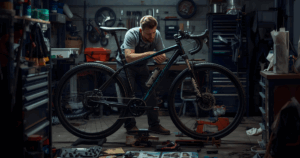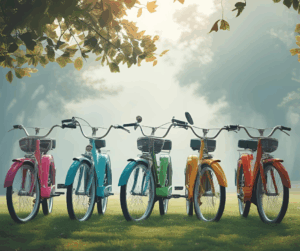Whether you’re a daily commuter, a weekend trail enthusiast, or just getting into cycling, developing good bike habits is key to making the most out of your two-wheeled experience. These habits go beyond simply knowing how to pedal or use your gears—they’re about safety, maintenance, etiquette, and long-term enjoyment. In an age where bikes and emobility products are transforming urban transportation, cultivating strong bike habits is more important than ever.
In this blog post, we’ll explore the essential bike habits every cyclist should know and practice. From the moment you pull your bike out of storage to your final ride of the week, these habits can dramatically improve your experience on and off the road.
1. Perform a Pre-Ride Safety Check
Before setting off on any ride, get into the habit of doing a quick safety check. This is one of the most underrated bike habits but arguably one of the most important.
Your pre-ride checklist should include:
- Tire Pressure: Use a gauge to make sure your tires are inflated to the recommended PSI.
- Brakes: Test both front and rear brakes to ensure they engage smoothly and stop you quickly.
- Chain & Drivetrain: Look for signs of rust, excessive dirt, or lack of lubrication.
- Bolts: Give your handlebars, seat, and wheels a quick tightening check.
These bike habits might only take 2–3 minutes, but they can prevent serious injuries and costly breakdowns.
2. Know and Respect Traffic Rules
Whether you’re riding on the road, a bike lane, or a park connector, obeying traffic laws is non-negotiable. Building bike habits that align with road safety is critical—not only for your protection but for the safety of others.
Always:
- Ride in the same direction as traffic.
- Obey stoplights and signs.
- Use hand signals when turning or stopping.
- Yield to pedestrians.
Good bike habits include learning the local cycling regulations—especially if you live in places like Singapore, where rules for cyclists are enforced under the Road Traffic Act and Active Mobility Act.
3. Stay Visible at All Times
One of the bike habits that can literally save your life is making sure you’re visible to drivers, especially at night or during poor weather conditions.
Here’s how:
- Wear bright, reflective clothing.
- Install front white and rear red lights.
- Add reflective tape to your helmet or backpack.
- Use hand signals clearly and confidently.
A good rule of thumb is: if you think you’re hard to see, you probably are. Get into the habit of making visibility a top priority every ride.
4. Keep Your Bike Clean and Well-Maintained
Regular maintenance is one of the foundational bike habits that even seasoned riders overlook. A clean bike isn’t just for looks—it runs better, lasts longer, and makes every ride smoother.
Weekly tasks:
- Wipe down your frame and components.
- Lubricate the chain (but don’t overdo it).
- Check for worn-out brake pads or frayed cables.
Monthly tasks:
- Inspect tire tread and replace if needed.
- Check spoke tension and wheel alignment.
- Clean the drivetrain thoroughly.
These bike habits are especially important if you ride frequently in the rain, mud, or on gravel trails, where wear and tear accumulate quickly.
5. Master Gear Shifting
Smooth and strategic gear shifting is more than just convenience—it helps extend the life of your drivetrain and ensures energy efficiency. Make it one of your regular bike habits to practice and perfect your gear changes.
Tips:
- Shift before a climb, not during.
- Avoid cross-chaining (e.g., big chainring + big cog).
- Ease off pedaling pressure when shifting.
Understanding when and how to shift gears based on terrain and cadence can transform your ride quality and prevent mechanical problems.
6. Ride Predictably and Defensively
Among the top bike habits to adopt is riding in a way that’s predictable to others. Sudden swerves, abrupt braking, or erratic lane changes confuse drivers, pedestrians, and other cyclists.
Instead:
- Hold a straight line whenever possible.
- Signal every turn.
- Make eye contact with motorists at intersections.
Defensive cycling doesn’t mean being timid—it means anticipating danger and making your presence and intentions crystal clear.
7. Hydrate and Fuel Strategically
Long rides require more than stamina—they require preparation. Developing bike habits around hydration and nutrition can greatly improve your endurance and post-ride recovery.
Before your ride:
- Drink water and have a light snack.
- Avoid alcohol or overly salty foods.
During your ride:
- Sip water every 15–20 minutes.
- Eat energy bars or fruits if riding longer than 60 minutes.
After your ride:
- Rehydrate with water or electrolyte drinks.
- Eat a mix of carbs and protein within 30–60 minutes.
Making hydration and fueling part of your routine bike habits will keep fatigue and cramps at bay.
8. Choose the Right Bike and Fit
One of the less obvious but impactful bike habits is ensuring your bicycle fits you correctly. A bike that’s too big or small can lead to back pain, knee strain, and overall discomfort.
Checkpoints for a good fit:
- Seat height allows a slight bend in the knee at the bottom of the pedal stroke.
- Handlebars are at a comfortable reach without overextending.
- Your riding posture feels natural, not forced.
Visit a bike shop for a professional fitting if needed. This one-time adjustment can influence many of your long-term bike habits.
9. Be Courteous on Shared Paths
In many cities, cyclists share space with pedestrians, joggers, and other riders. Adopting courteous bike habits ensures everyone enjoys the space safely.
Practice:
- Slowing down in crowded areas.
- Giving audible signals (“on your left!” or a bell ring).
- Avoiding aggressive overtaking.
Respect and communication go a long way in promoting a positive cycling culture. It’s not just about rules—it’s about attitude.
10. Log Your Rides
Technology can be a great motivator for developing consistent bike habits. Use cycling apps like Strava, Komoot, or Ride with GPS to track your rides, set goals, and measure improvement.
Benefits:
- Visualize your progress.
- Set weekly or monthly distance goals.
- Join community challenges.
Logging rides also helps you understand patterns—like what time of day you ride best or how weather impacts your pace.
11. Invest in Quality Gear
One of the long-term bike habits that will pay off is investing in reliable gear. This includes:
- A well-ventilated helmet.
- Padded cycling shorts.
- Gloves for grip and comfort.
- Rainproof jackets for wet weather.
Quality gear isn’t about luxury—it’s about safety and performance. It’s one of those bike habits that elevate your entire experience from good to great.
12. Learn Basic Bike Repairs
Bike breakdowns can be frustrating, especially when you’re miles from help. Learning basic repairs is one of the smartest bike habits for independence and confidence.
Start with:
- Fixing a flat tire.
- Adjusting brakes and gears.
- Replacing a broken chain link.
Keep a small tool kit and spare tube in your bag. It’s empowering to know you can troubleshoot common issues on the fly.
13. Plan Your Route
One of the smarter bike habits is to plan your rides ahead of time. Whether you’re commuting to work or exploring new trails, mapping your route can prevent detours and enhance safety.
Use:
- Google Maps (cycling mode).
- Dedicated apps like MapMyRide or Bike Map.
- Local bike infrastructure websites.
Consider elevation, traffic levels, and bike-friendly paths. Well-planned rides are often the most enjoyable and productive.
14. Ride Year-Round (Safely)
Cycling isn’t just a fair-weather sport. With the right gear and mindset, riding year-round is possible—and it reinforces consistency in your bike habits.
For rainy or humid days:
- Use mudguards.
- Choose water-resistant clothing.
- Avoid metal grates and painted surfaces—they get slippery.
For colder days:
- Layer up appropriately.
- Use insulated gloves and socks.
Adjusting your bike habits for different seasons makes you a more versatile and resilient rider.
15. Respect Your Limits
Not every ride needs to be a record-breaker. Some of the wisest bike habits involve listening to your body.
If you’re feeling fatigued, cut the ride short. If your knee aches, take a day off. Pushing too hard leads to burnout or injury, which can derail your progress.
Cycling is a long-term journey. Consistency trumps intensity every time.
Conclusion: Good Habits Make Great Riders
Whether you’re pedaling through city traffic or climbing a quiet hill, good bike habits are what transform average riders into confident, skilled cyclists. They keep you safe, extend the life of your bike, and enhance the joy of riding.
From mastering basic maintenance to riding respectfully on shared paths, each of these 15 habits plays a part in your cycling journey. As ebikes and other emobility options become more common, these practices apply to all two-wheeled riders—not just traditional cyclists.
So the next time you gear up, ask yourself: which bike habits are helping me ride better today—and which ones do I still need to build? The more mindful you are, the more rewarding every ride will be.





